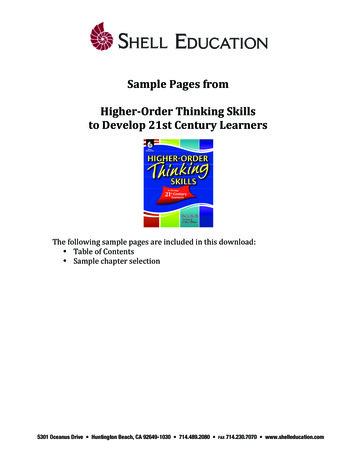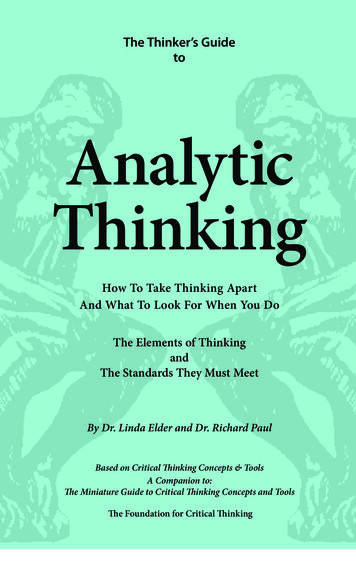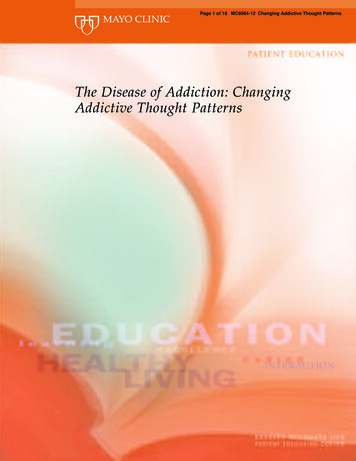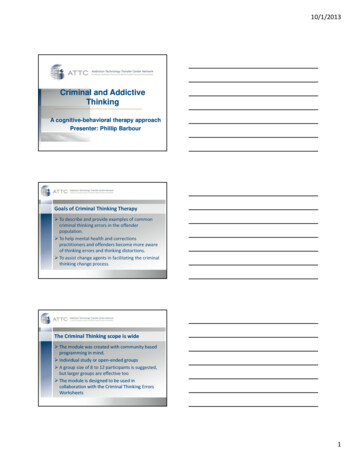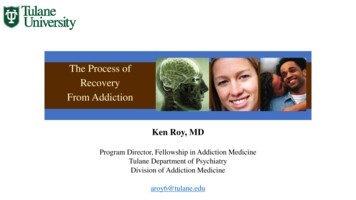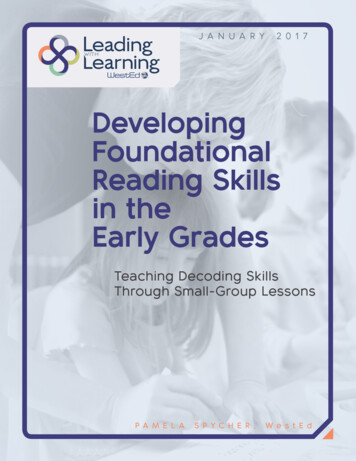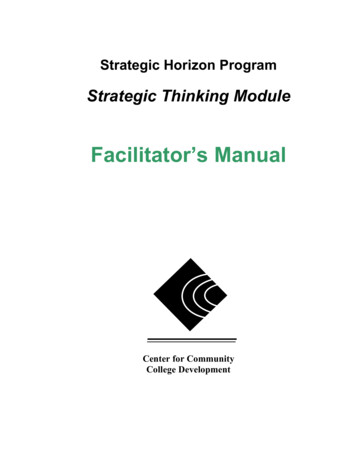
Transcription
Swartz and McGuinnessDeveloping and Assessing Thinking SkillsFinal Report Part 2 February 2014DEVELOPING AND ASSESSINGTHINKING SKILLSThe International Baccalaureate ProjectFinal Report Part 2Evaluation of Current IB ProgrammesFebruary 2014byRobert SwartzNational Center for Teaching ThinkingBoston, USAandCarol McGuinnessQueen’s University BelfastNorthern IrelandFunded by The International Baccalaureate Organisation1
Swartz and McGuinnessDeveloping and Assessing Thinking SkillsFinal Report Part 2 February 2014Table of Contents1 The Purpose and Scope of the Final Report Part 2Page32 Methodology63 The Primary Years Programme114 The Middle Years Programme285 The Diploma Programme456 Recommendations632
Swartz and McGuinnessDeveloping and Assessing Thinking SkillsFinal Report Part 2 February 20141 The Purpose and Structure of the Part 2 ReportIn the initial proposal we identified two main questions to be answered in our reports. There were: The state of the art today with regard to identifying important and teachable kinds ofthinking, how they can be taught, and how they can be assessed. How the present IB programmes align with this picture.While the focus of the Part 1 Report was on the first question, the main focus for this Part 2 Report isto evaluate the extent to which the three IB programmes align with the principles and practices thatwere identified in the first report.To begin, we return to the concluding overview from the Part 1 Report that is synthesized into Table1.1 below. The table is structured into three main columns related to (1) Thinking Objectives in acurriculum; (2) Teaching Thinking, Principles and Practices; and (3) Assessing Thinking, Principles andPractices.We will use the more detailed statements in each column as criteria against which toevaluate the IB programmes.As the reader will see in the Methodology Section 2, these criteriaalso form the basis for the coding scheme that we used as a tool to interrogate and record ourobservations from the IB documents.3
Swartz and McGuinnessDeveloping and Assessing Thinking SkillsFinal Report Part 2 February 2014Table 1.1 An Integrated Research and Practice Informed Framework for Developing andAssessing Thinking Skills and Related ciplesPracticesPrinciplesPracticesMake thinkingorganisers intheclassroom, graphic organisers,thinking routinesAlign teaching andassessmentpractices withthinking objectivesin the classroom.Prompt studentperformances thatdisplay the use ofthinking skills, habitsof mind, and theefficacy of thinkingdispositions.Thinking SkillsGivestudentssomethingchallenging to think about, morethan routine tasksAdvancedeepthinking challengesEngage students incollaborativethinking to ensurejointmeaningmaking, interaction,and dialogueMetacognitionPrompt students toadoptastrongmetacognitiveperspectiveTeach for transfer ofthe skilful thinkingbeing learnedThinkingDispositionsCultivate thinkingdispositions andhabit and mindsGeneralise theapproach fromthinking classroomsacross all grades inthe schoolPrompt the students to make thethinking that results from theiruse visible and publicUse collaborative groups, arrangethe classroom to facilitateinteraction, develop a thinkinglanguage, support sustaineddialogue about thinkingBe specific about theperformance criteriaand standardsexpected for the useofDesign assessmentrubrics and ratingsthat incorporateThinking SkillsSpecific ispositionsNext StepsTeach students explicit strategiesto plan, monitor and evaluatetheir thinking skills and thinkingdispositions. Give time to do this.Growth PatternsExplicitly teaching to facilitate thetransfer of learned thinkingprocedures to other curricularand non-curricular contexts;Create classroom norms andexpectations aboutthoughtfulness and the habitualuse of thinking strategiesPrioritise teachers’ professionaldevelopment and teachers’planning timeAdopt assessmentfor learningprinciplesShare the criteria andstandards withstudentsGive feedback andidentify next stepsUse self and peerassessment tocommunicate andshare standards,promote assessmentliteracy re thinkingobjectives4
Swartz and McGuinnessDeveloping and Assessing Thinking SkillsFinal Report Part 2 February 2014The source documents we have consulted on the OCC are:For PYPMaking the PYP happenPYP A basis for practicePYP A model of transdisciplinary learningPYP Developing a transdisciplinary programmePYP PlannerPYP Exhibition guidelinesAssessment in the PYP Annotated samplesFor MYPFrom Principles to PracticeTeaching the disciplines in the MYP: Nurturing big ideas and deep understandingPersonal Project Guide (2011-2013)Powerpoint for Unit Planning in MYPCo-ordinators’ Handbook 2013-2014Command Terms in the MYPHumanities Subject GuideScience Subject GuidePhysical Education Subject GuideArts Subject GuideApproaches to Learning Literature ReviewExamples of assessed student workFor the DiplomaTheory of Knowledge GuideDiploma Assessment Principles and PracticeCAS GuideExtended Essay GuideGrade Descriptors for several subjectsCommand Terms in the MYP (which is relevant for DP as well)Examples of student presentations for TOKWe have also browsed the OCC and briefly reviewed a range of other materials that we consideredmight be useful (e.g., the history of the various programmes). From these documents we have builtup a picture of the educational philosophy of the IB programmes, together with the distinctiveorientations, curriculum elements and practices of each individual programme – PYP, MYP and theDiploma. Nevertheless, it should be emphasised at this stage that our analysis is necessarilyconfined to what we can find out through the analyses of documents, and this is limited comparedto being able to see what actually goes on in IB schools.The remainder of the report is structured into the following sections:5
Swartz and McGuinnessDeveloping and Assessing Thinking SkillsFinal Report Part 2 February 2014Section 2 outlines the rationale for the design of the coding matrices that were used to evaluate theIB programmes. This section is almost identical to the proposed methodology that was submittedas part of the original proposal.Section 3 reports an evaluation of the thinking objectives, the teaching of thinking practices, and theassessment of thinking practices, using the coding matrices for analysing the PYP curriculumdocuments. The section ends with recommendations for the PYP.Section 4 reports an evaluation of the thinking objectives, the teaching of thinking practices, and theassessment of thinking practices, using the coding matrices for analysing the MYP curriculumdocuments. The section ends with recommendations for the MYP.Section 5 reports an evaluation of the thinking objectives, the teaching of thinking practices, and theassessment of thinking practices, using the coding matrices for analysing the Diploma curriculumdocuments. The section ends with recommendations for the DP.Section 6 draws together the recommendations for the three IB programmes.2 Methodology2.1 Overview of the Coding Matrices for the Document AnalysesThree different Coding Matrices were created – For interrogating and coding the IB programmes with regard to thinking goals and thinkingobjectives in the curriculum; Interrogating and coding the IB programmes with regard to pedagogical approaches forenhancing thinking; Interrogating and coding the IB programmes with regard to practices for assessing thinking.Each matrix has a basic similar coding structure, with slight variations for each of the three purposes.On the vertical dimension of the matrix are the thinking-related constructs that have emerged asimportant from the research and practice literature in the Part 1 Report.These are commonacross all matrices. Once again, they are:Thinking Skills: Using this code, documents were examined for reference to thinking processes ofany kind that are taught, both general and specific (with one exception, see below). Examples couldbe contained, for example, in critical thinking activities, activities requiring evaluation, excursionsinto analysis, classification projects, requests for prioritising tasks and items, engagement inproblem-solving, thinking about options, creating an argument, or developing creative ideas. Whilethe coding required that the type of thinking is merely mentioned at a general level, the6
Swartz and McGuinnessDeveloping and Assessing Thinking SkillsFinal Report Part 2 February 2014commentary explains whether it is described in sufficient detail such that it can become bothteachable and eventually assessable. This is a more demanding criterion than just naming the typeof thinking, important though that is.Thinking Dispositions:Using this code, documents were examined for reference to any learnerattributes associated with dispositional support of thinking. Examples might include practising openmindedness, curiosity, being persistent, striving for accuracy, being adventurous and taking riskswith ideas, and related constructs such as an overall commitment to thinking as a way of trying tosolve problems. Again, while the coding criterion required that thinking dispositions are just namedthe commentary explains whether they are described in sufficient detail to make them bothteachable and assessable.Metacognitive Thinking: This type of thinking in which we think about our own thinking in a varietyof ways was coded separately because of the central role that it plays in the development of thinkingand its role in teaching thinking. Examples might include having students develop a plan for solvinga problem, prompts to follow a thinking procedure introduced earlier, and overall evaluation of theway a student engages in key types of thinking like decision making. Different terms might be usedto describe this kind of thinking – thinking about thinking, reflective thinking, managing thinking,strategic thinking, self-management (although this term is broader than metacognition). Whateverthe term used, the coding required that the type of thinking was just named while the commentaryexplains if it was described in sufficient detail to make it both teachable and assessable.Beliefs about Knowledge:Using this code, documents will be examined for reference to beliefsabout knowledge and the role they might have influencing both thinking dispositions and a student’sability to engage in thinking. Examples might include references to the status of knowledge –absolute vs. relative, provisional knowledge, the nature of truth claims in various disciplines and thecriteria used to assess them, knowledge creation in historical or social contexts. Initially, weconsidered that this code was likely to become more prominent in the IB programmes for olderstudents. Although we continued to report on the evaluations of all the programmes using the code,we have not given it the same status as the other codes, as there is not the same consensus in theresearch/practice literature about its importance as the other codes.The headings for the horizontal dimension of the matrix differ depending on the purpose –curriculum, pedagogy, and assessment. These will be described as each matrix is introduced.7
Swartz and McGuinnessDeveloping and Assessing Thinking SkillsFinal Report Part 2 February 2014Each IB programme – Primary Years, Middle Years and Diploma programmes – will be examinedseparately and coded into separate matrices for these different levels.2.2. Coding thinking at the level of thinking goals and thinking objectives in the curriculumIB curriculum documents were interrogated to evaluate whether or not the various thinkingconstructs are mentioned, how frequently they are mentioned, and how detailed is the descriptionin the different types of curriculum documentation. The horizontal codes are intended to identifydocuments at different levels of specificity. The purpose is to drill down through the documentationto see if thinking goals articulated at the general level successfully find their way into specific plans.Thinking ivesat subject levelTransdisciplinaryThemes, Areas ssonPlans(if available)Thinking iefsKnowledgeabout2.3 Coding thinking at the level of pedagogical approachTeaching approaches and workshop materials were interrogated to evaluate the extent to whichthinking is promoted in the ways identified on the horizontal axis, and through the general andopen-ended questions at the top and bottom of the matrix.In this coding matrix the headings across the horizontal dimension refer to pedagogical principlesand practices that are known to be important for teaching thinking – making thinking explicit, usingvarious methods for making thinking more visible, direct instruction in certain forms of thinking,engaging in exploratory talk, collaborative work around thinking, teaching for transfer.Werecognise that the available documentary material with regard to interrogating pedagogy is limitedwithout access to direct classroom observations.8
Swartz and McGuinnessDeveloping and Assessing Thinking SkillsFinal Report Part 2 February 2014What is the general approach to promoting and enhancing thinking?Thinking ConstructThe degree to whichreference to thinkingis made explicit orvisible in theclassroomWhat methods are employedto make thinking explicit?(thinking organisers, graphicorganisers thinking routinesdialogue, collaborative work,)The degree to which effortsare made to rehearsethinking across differentcontexts (teach fortransfer)Thinking SkillsThinking DispositionsMetacognitive ThinkingBeliefs about KnowledgeIs there any reference to ideas such as thinking classrooms, cultures of thinking, communities of enquiry, etc.?2.4 Coding thinking at the level of practices for assessing thinkingIt is recognised that assessments can differ with regard to WHO makes the assessment (teacher,peer, self or external agent), the PURPOSE of the assessment (formative or summative) and thePERFORMANCE that is being assessed (e.g., oral presentation, group discussion, enquiry project,essay, portfolio). However, we consider that, irrespective of these other considerations, the extentto which the assessment task not only REQUIRES specific sorts of thinking, but whether the way thetask is formulated can give us a reliable assurance that student responses will reveal the thinking inquestion, are quite essential in successful assessments of thinking. Also crucial is to what degree themarking criteria include explicit criteria related to thinking, to what extent the markingschemes/rubrics indicate the level of performance that has been achieved, and how theperformance/grade is reported back to the student.9
Swartz and McGuinnessDeveloping and Assessing Thinking SkillsFinal Report Part 2 February 2014With reference to any assessment task, formative or summative, externally assessed, teacher assessed, orpeer/self-assessed, the following will be examinedThinking ConstructThe question that is set,what is asked of thestudent, the teacherpromptSuccess Criteria,Marking CriteriaMarking Schemes,Rubrics,Indicators about the levelof performance gDispositionsBeliefs aboutKnowledgeAll available curriculum, teaching support, assessment guidance and assessment examples wereinterrogated for the extent to which the questions that are set and the teacher prompts actuallyrequire students to think in desirable ways, and the extent to which the criteria used to judge thequality of thinking that is presented reveal that quality, and are actually used in marking criteria or inmarking schemes that clearly articulate the level of skill revealed in the thinking episode beingassessed. We will also assess the extent to which these criteria are shared with the students in thespirit of assessment for learning and used as the basis for feedback and next steps.10
Swartz and McGuinnessDeveloping and Assessing Thinking SkillsFinal Report Part 2 February 20143The Primary Years Programme3.1 General OverviewThe Primary Years Programme is essentially a transdisciplinary curriculum consisting of a programmeof inquiries on key transdisciplinary themes which are designed and conducted across each primaryyear/grade and built up over the whole primary phase. Six inquiries are completed by the studentseach year (4 in the early years) and these are timetabled alongside teaching in specific subjectswhich follow either the IB scope and sequence or a nationally or locally prescribed curriculum.Overall, students could complete up to 50 inquiries during the course of their primary education –presuming they are at pre-school and primary school from 3-12 years. Students’ inquiry experienceculminates in a major class inquiry called the Exhibition in the final year of primary school.students’ work – oral, written and other performances are internally assessed.AllThere are norequired external assessments.The focus of the current analysis is on the development and assessment of thinking skills which arebriefly coded in the three matrices as outlined in the proposal. The text accompanying each matrixprovides a more extended commentary and critique.11
Swartz and McGuinnessDeveloping and Assessing Thinking SkillsFinal Report Part 2 February 20143.2 Thinking Objectives and Goals in the PYP (Coding Matrix inesThinkingTransdisciplinaryObjectivesKey Conceptsatsubject SkillslevelUnitsof IB profile refers toa number ofthinking processesparticularly underthe attributes of‘thinkers’ and‘inquirers’Subject specificskills are outlinedin scope andsequence forsubjectsAlltransdisciplinarylearning is theobjective of theExhibition(Key concepts offerrich opportunities fordeveloping specifictypes of thinking.However, thetransdisciplinarythinking skills are notlinked to the keyconcepts for thispurpose)IB profile refers toa number ofthinkingdispositionsparticularly underthe attributes of‘openmindedness’ and‘risk takers’No mentionPYP attitudes –creativity, curiosity,confidence,independenceIB profile describesan attribute ofbeing reflectiveabout learningNo mentionbeyond Reflectionas a Key ConceptMetacognition isincluded as one ofthe transdisciplinarythinking skillsThere is a strongemphasisthroughout onreflection for thepurposes ofmaking meaningBeliefs aboutKnowledgeKey concepts areexemplified at thesubject level butthinking skills arenotThinking Skills(modification ofBloom’s Taxonomy)References also tothinking processes inother skill domains –social, research,communication andself-managementIB ProfileThemesKey ConceptsThinking SkillsOther SkillsAttitudesThere arequestions in theinquiry to promptteachers to includetransdisciplinaryskills.Precise thinkingskills do not haveto be specified inthe inquiry, unlikekey concepts whichdo have tospecified and thusdrive theunderstanding ofthe central ideaReference tometacognitivethinking in the keyconcept ‘reflection’Some reference in the transdisciplinary key concept ‘reflection’ about evidence, bias and reliability andwhat it means to know in different disciplines.12
Swartz and McGuinnessDeveloping and Assessing Thinking SkillsFinal Report Part 2 February 2014The primary focus for developing thinking and related attributes can be found in thetransdisciplinary component of the curriculum which consists of several different themes, concepts,skills and attitudes.For example, the transdisciplinary themes are organised around sevenquestions (Who we are? Where we are in place and time? How we express ourselves? How theworld works? How we organise ourselves? Sharing the planet?). The themes are sufficiently broadto generate many different central ideas which form the basis for the inquiries.Essentially, thethemes define the content of an inquiry and how it might link to, or depend on, teaching in thespecific subject areas.More importantly, for the development of thinking, are the other transdisciplinary elements –thetransdisciplinary skills, attitudes and the key concepts. The overarching IB learner profile alsoidentifies attributes that are relevant to thinking skills and thinking dispositions.These will bediscussed, in turn, as a basis for providing the key ingredients for a thinking curriculum.3.2.1Transdisciplinary SkillsSix different frameworks capture a range of skills – thinking skills, research skills, communicationskills, social skills, and self-management skills. So there are many frameworks to support learninggoals with potential relevance for thinking.The thinking skills framework essentially consists of Bloom’s taxonomy (acquisition of knowledge,comprehension, application, synthesis and evaluation) with some additions (dialectical thought, andmetacognition). Bloom’s taxonomy is very widely used as the basis for highlighting the importanceof higher order thinking as a learning objective. However, the main problem with the taxonomy, aswe commented in Part 1 Report, Section 2.2, is that its original intention was to identify learningobjectives or learning outcomes and it is not framed in a language that makes the thinking processamenable for instruction. Although more recent reformulations of the taxonomy have attempted torefocus the objectives in a more thinking-oriented language, additional work still remains to be doneto turn Bloom’s categories into thinking strategies that would be useful for instructional purposes.For example, if the thinking objective is set as ‘analysis’ and the cognitive demand of a task is to‘compare and contrast two things’, then further elaboration is required to turn this command into athinking strategy such that a student can potentially learn how to do it, that a teacher could modelit, or that it could become the focus for instruction in a variety of different ways. We haveelaborated on this point extensively in Section 2.2 and Section 2.3 of the Part 1 Report.In thecontext of PYP, an articulation of Bloom’s Taxonomy as in Figure 8, p.21, Making PYP Happen, is an13
Swartz and McGuinnessDeveloping and Assessing Thinking SkillsFinal Report Part 2 February 2014ideal place to do this elaboration, perhaps using the model we articulate in Part 1, Section 2.2(copied below).The other transdisciplinary skills frameworks also identify thinking-related processes that couldbenefit from being more explicitly linked to the main thinking skills framework. For example, in theResearch Skills framework, references are made to ‘sorting and categorising information’, and‘drawing conclusions from relationships and patterns that emerge from organised data’. While thesethinking objectives are more or less consistent with Bloom, the social skills and self-managementskills framework reference types of thinking more oriented towards actions – towards problemsolving and decision-making – that do not fit so well within Bloom.For example, under SocialSkills/group decision-making, there is reference to ‘discussing ideas, asking questions, workingtowards and obtaining consensus’. While these could be articulated in more detail, they doreference a more interactive and dialogic form of thinking that is also poorly represented in Bloom.Another example can be seen in the Self-Management and Research Skills frameworks wherereference is made under ‘organisation’ and ‘planning’ to anticipatory thinking and forethought as aprelude to problem-solving – ‘planning and carrying out activities effectively’, developing a course ofaction, writing an outline, devising ways of finding out necessary information; ‘selecting anappropriate course of action or behaviour based on fact’. Articulation of a clearer decision makingstrategy like we outline in Part1, Section 2.2 and 2.3, would pull these ways of speaking together.And, as we suggest in Part 1, the following can be added to the list of types of thinking that need tobe taught skillfully above:14
Swartz and McGuinnessDeveloping and Assessing Thinking SkillsFinal Report Part 2 February 2014IV Complex ThinkingProcesses1.Decision Making2.Problem Solving3.2.2 Key ConceptsKey concepts are considered to be an essential element of the PYP. The PYP is committed to a‘concept-driven curriculum’ as a means of supporting inquiries. The general argument is thateducation often focuses on rote learning and superficial understanding at the expense of studentsgaining a deeper understanding of significant ideas.Thus the role played by key concepts is todeepen understanding by having students re-visit the key concepts and appreciate how theytranscend subject boundaries.Key concepts thus act as a meta-framework and help to increaseconceptual coherence right across the curriculum, both in the programme of inquiries and in subjectspecific teaching. The key concepts identified for the PYP are Form, Function, Causation, Change,Connection, Perspective, Responsibility and Reflection. These key concepts are exemplified in eachof the subject guides and they are the only transdisciplinary element to be illustrated in this way (asfar as we can find). Key concepts are very well developed in the PYP documentation and a lot oflearning seems to depend on them. For example, it is claimed that “A concept-driven curriculumhelps the learner to construct meaning through improved critical thinking and the transfer ofknowledge”. In other curricula with an emphasis on improving higher order thinking or criticalthinking (e.g., the new Northern Ireland Curriculum, introduced in 2007, or Key Competences in theNew Zealand Curriculum), it is not unusual for a thinking framework rather than a key conceptframework to be assigned this cross-cutting curriculum role.However, adding an appropriatethinking framework to drive the application of these concepts will give the students who go throughthe PYP a richer and deeper learning framework, and could connect it to the MYP and the DP intowhich the same thinking framework could be embedded.So, though not explicitly declared as part of the PYP thinking skills framework, we have examined thekey concepts with regard to their instructional potential for enhancing thinking as well as deepeningunderstanding.Other school curricula who adopt an intentional ‘infusion’ approach to teachingthinking would generally expect to deliver on both objectives – deep understanding and enhancedthinking, though none (to our knowledge) have developed cross-cutting key concepts (though theideas has emerged in the New Generation Standards for Science in the US).PYP may be in a15
Swartz and McGuinnessDeveloping and Assessing Thinking SkillsFinal Report Part 2 February 2014unique position to make explicit linkages between a concept-based curriculum and a thinking-basedcurriculum thus breaking through any false dichotomies there may be between teaching forunderstanding and teaching for thinking.The eight key concepts identified are: Form, Function, Causation, Change, Connection, Perspective,Responsibility, and Reflection.They are currently framed in terms of a key question, definition,rationale, and examples of related concepts. It would not be too great a jump to include examplesof the kinds of thinking skills that would map onto the demands of understanding the concept andwhere a greater skillfulness in a certain type of thinking would help the student probe the keyconcept and deepen their understanding of the concept in context. For example:“Key Concept: FormKey question What is it like?Definition The understanding that everything has a form with recognizable features that can beobserved, identified, described and categorized.Rationale This concept was selected because the ability to observe, identify, describe and categorizeis fundamental to human learning within and across all disciplines.Examples of related concepts Properties, structure, similarities, differences, pattern.”The cognitive demand involved in understanding the concept seems to involve being able to identifyfeatures, to characterise patterns, and to categorise. One of the most common articulated thinkingstrategies to serve this purpose (at Bloom’s level of analysis) is to compare and contrast, following asimple set of questions.Compare and Contrast: How are they similar (with regard to form)? How are they different (withregard to form)? What similarities and differences seem to be important? What categories orpatterns do you see among the similarities and differences? What conclusion is suggested by thesepatterns?Comparing and contrasting is one of the ways we do analysis. And, indeed, it is one of the forms ofthinking that students can be taught to do skilfully. The strategy quoted above can be taken todefine this skill. (Please note: the way we treat compare and contrast here rejects the idea that itjust involves listing similarities and differences. Rather, to do this kind of thinking skillfully involvesasking and answering the additional extending questions.)These questions could be included as prompts for the key concept FORM.16
Swartz and McGuinnessDeveloping and Assessing Thinking SkillsFinal Report Part 2 February 2014Another example is:“Key Concept FunctionKey question How does it work?Definition The understanding that everything has a purpose, a role or a way of behavingthat can be investigated.Rationale This concept was selected because the ability to analyse function, role, behaviour and theways in which things work is fundamental to learning within and across all disciplines.Examples of related conceptsBehaviour, communication, pattern, role, systems.”From a Bloom perspective, the cognitive demand involved in understanding this concept is also aform of analysis, asking the student to examine a ‘whole’ in t
Thinking Skills Thinking Dispositions Metacognitive Thinking Beliefs about Knowledge 2.3 Coding thinking at the level of pedagogical approach Teaching approaches and workshop materials were interrogated to evaluate the extent to which thinking is promoted in the ways ident

